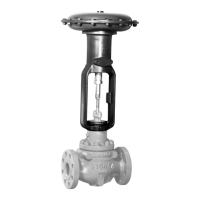Type 655 and 655R
7
3. Replace the spring and reassemble the actuator by
following steps 5 and 6 of the
Assembly
portion of the
Maintenance
section.
Shutdown
For both pressure-reducing and pressure-relief ap-
plications, refer to figure 3, and follow the procedures
described below.
1. Close the upstream shutoff valve slightly.
2. Slowly open the bypass valve while monitoring
downstream pressure.
3. Slowly close the downstream shutoff valve.
4. Close the upstream shutoff valve.
5. Close the needle valve in the control line.
Maintenance
Actuator parts are subject to normal wear and must be
inspected and replaced when necessary. The frequen-
cy of inspection and replacement depends on the se-
verity of service conditions.
WARNING
Avoid personal injury or property dam-
age from sudden release of pressure,
uncontrolled process fluid, or precom-
pressed spring force. Before starting
disassembly:
D Isolate the regulator or relief valve
from the system pressure, and relieve all
internal pressure
D Release spring compression as de-
scribed in step 2 of the Disassembly
section
The maintenance instructions are divided into two sec-
tions:
Actuator
and
Top-Mounted Handwheel
.
Actuator
This procedure describes how the actuator can be
completely disassembled and assembled. When in-
spection or repairs are required, disassemble only
those parts necessary to accomplish the job; then,
start the assembly at the appropriate step.
Key numbers refer to figure 5.
Disassembly
CAUTION
In the following procedure, do not rotate
the valve plug while it is seated since
this may cause damage to the seating
surfaces and thereby allow excessive
leakage. Also, during travel adjustment,
use tools carefully to avoid damaging
the valve plug stem. A damaged stem
could cut the packing and allow leak-
age.
1. Rotate the handwheel (if one is used) counterclock-
wise to be sure the handwheel is not compressing the
spring (key 6).
2. For complete disassembly, the actuator must be
removed from the valve, and the actuator stem (key 8)
must be completely disengaged from the valve plug
stem by rotating the actuator. Perform the appropriate
procedure according to the respective valve action.
For Push-Down-To-Close Valves:
Note
To prevent the actuator stem (key 8)
from rotating while performing the fol-
lowing procedure, make sure the adjust-
ing screw (key 10) remains screwed into
the yoke (key 7).
a. Loosen the two hex nuts (key 12).
b. Loosen the yoke locknut (figure 4) with a ham-
mer and punch, and unscrew it from the valve bon-
net.
c. While lifting the actuator so that the valve plug is
not forced against the seat, rotate the entire actua-
tor until the actuator stem disengages completely
from the valve plug stem.
For Push-Down-To-Open Valves:
a. Turn the adjusting screw (key 10) counterclock-
wise to relieve all spring compression. Then, move
the valve plug, by hand, off the seat.
b. Loosen the hex nuts (key 12), and unscrew the
valve plug stem out of the actuator stem as far as it
will go.
c. Turn the adjusting screw into the yoke (key 7) to
force the diaphragm (key 2) and diaphragm plate
(key 4) against the upper diaphragm casing (key 1).
d. Loosen the yoke locknut (figure 4) with a ham-
mer and punch, and unscrew it from the valve bon-
net.

